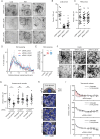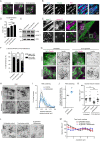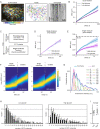Organization and dynamics of the cortical complexes controlling insulin secretion in β-cells
- PMID: 35006275
- PMCID: PMC8918791
- DOI: 10.1242/jcs.259430
Organization and dynamics of the cortical complexes controlling insulin secretion in β-cells
Abstract
Insulin secretion in pancreatic β-cells is regulated by cortical complexes that are enriched at the sites of adhesion to extracellular matrix facing the vasculature. Many components of these complexes, including bassoon, RIM, ELKS and liprins, are shared with neuronal synapses. Here, we show that insulin secretion sites also contain the non-neuronal proteins LL5β (also known as PHLDB2) and KANK1, which, in migrating cells, organize exocytotic machinery in the vicinity of integrin-based adhesions. Depletion of LL5β or focal adhesion disassembly triggered by myosin II inhibition perturbed the clustering of secretory complexes and attenuated the first wave of insulin release. Although previous analyses in vitro and in neurons have suggested that secretory machinery might assemble through liquid-liquid phase separation, analysis of endogenously labeled ELKS in pancreatic islets indicated that its dynamics is inconsistent with such a scenario. Instead, fluorescence recovery after photobleaching and single-molecule imaging showed that ELKS turnover is driven by binding and unbinding to low-mobility scaffolds. Both the scaffold movements and ELKS exchange were stimulated by glucose treatment. Our findings help to explain how integrin-based adhesions control spatial organization of glucose-stimulated insulin release.
Keywords: Cell cortex; Focal adhesion; Insulin secretion; Knock-in mouse; Liquid–liquid phase separation; Single-molecule imaging.
© 2022. Published by The Company of Biologists Ltd.
Conflict of interest statement
Competing interests The authors declare no competing or financial interests.
Figures






Similar articles
-
ELKS, a protein structurally related to the active zone-associated protein CAST, is expressed in pancreatic beta cells and functions in insulin exocytosis: interaction of ELKS with exocytotic machinery analyzed by total internal reflection fluorescence microscopy.Mol Biol Cell. 2005 Jul;16(7):3289-300. doi: 10.1091/mbc.e04-09-0816. Epub 2005 May 11. Mol Biol Cell. 2005. PMID: 15888548 Free PMC article.
-
Role of the active zone protein, ELKS, in insulin secretion from pancreatic β-cells.Mol Metab. 2019 Sep;27S(Suppl):S81-S91. doi: 10.1016/j.molmet.2019.06.017. Mol Metab. 2019. PMID: 31500835 Free PMC article. Review.
-
Insulin secretion hot spots in pancreatic β cells as secreting adhesions.Front Cell Dev Biol. 2023 May 26;11:1211482. doi: 10.3389/fcell.2023.1211482. eCollection 2023. Front Cell Dev Biol. 2023. PMID: 37305687 Free PMC article.
-
ELKS/Voltage-Dependent Ca2+ Channel-β Subunit Module Regulates Polarized Ca2+ Influx in Pancreatic β Cells.Cell Rep. 2019 Jan 29;26(5):1213-1226.e7. doi: 10.1016/j.celrep.2018.12.106. Cell Rep. 2019. PMID: 30699350
-
Recent new insights into the role of SNARE and associated proteins in insulin granule exocytosis.Diabetes Obes Metab. 2017 Sep;19 Suppl 1:115-123. doi: 10.1111/dom.13001. Diabetes Obes Metab. 2017. PMID: 28880475 Review.
Cited by
-
Luminescent sensing of conformational integrin activation in living cells.Cell Rep. 2025 Feb 25;44(2):115319. doi: 10.1016/j.celrep.2025.115319. Epub 2025 Feb 17. Cell Rep. 2025. PMID: 39964812 Free PMC article.
-
CAMSAPs and nucleation-promoting factors control microtubule release from γ-TuRC.Nat Cell Biol. 2024 Mar;26(3):404-420. doi: 10.1038/s41556-024-01366-2. Epub 2024 Feb 29. Nat Cell Biol. 2024. PMID: 38424271 Free PMC article.
-
Local activation of focal adhesion kinase orchestrates the positioning of presynaptic scaffold proteins and Ca2+ signalling to control glucose-dependent insulin secretion.Elife. 2022 May 13;11:e76262. doi: 10.7554/eLife.76262. Elife. 2022. PMID: 35559734 Free PMC article.
-
Signal transduction pathways controlling Ins2 gene activity and beta cell state transitions.iScience. 2025 Feb 17;28(3):112015. doi: 10.1016/j.isci.2025.112015. eCollection 2025 Mar 21. iScience. 2025. PMID: 40144638 Free PMC article.
-
Directed insulin secretion from beta cells occurs at cortical sites devoid of microtubules at the edges of ELKS/LL5β patches.bioRxiv [Preprint]. 2025 Mar 27:2024.10.31.621333. doi: 10.1101/2024.10.31.621333. bioRxiv. 2025. Update in: Mol Biol Cell. 2025 Jun 1;36(6):ar68. doi: 10.1091/mbc.E24-10-0487. PMID: 39553950 Free PMC article. Updated. Preprint.
References
Publication types
MeSH terms
Substances
LinkOut - more resources
Full Text Sources
Molecular Biology Databases

